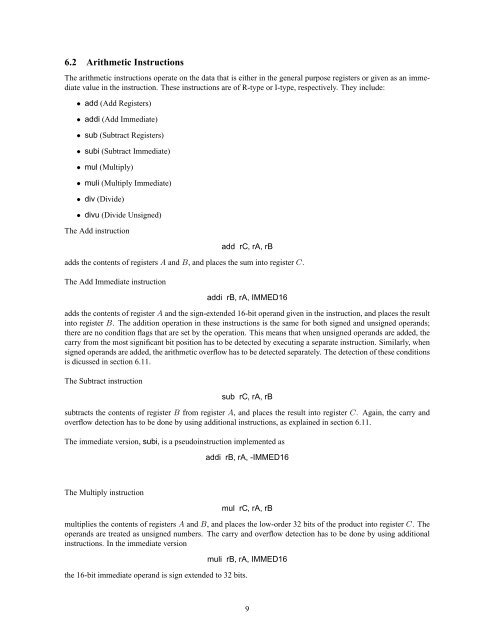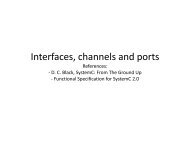Introduction to the Altera Nios II Soft Processor - FTP - Altera
Introduction to the Altera Nios II Soft Processor - FTP - Altera
Introduction to the Altera Nios II Soft Processor - FTP - Altera
You also want an ePaper? Increase the reach of your titles
YUMPU automatically turns print PDFs into web optimized ePapers that Google loves.
6.2 Arithmetic Instructions<br />
The arithmetic instructions operate on <strong>the</strong> data that is ei<strong>the</strong>r in <strong>the</strong> general purpose registers or given as an immediate<br />
value in <strong>the</strong> instruction. These instructions are of R-type or I-type, respectively. They include:<br />
• add (Add Registers)<br />
• addi (Add Immediate)<br />
• sub (Subtract Registers)<br />
• subi (Subtract Immediate)<br />
• mul (Multiply)<br />
• muli (Multiply Immediate)<br />
• div (Divide)<br />
• divu (Divide Unsigned)<br />
The Add instruction<br />
add rC, rA, rB<br />
adds <strong>the</strong> contents of registers A and B, and places <strong>the</strong> sum in<strong>to</strong> register C.<br />
The Add Immediate instruction<br />
addi rB, rA, IMMED16<br />
adds <strong>the</strong> contents of register A and <strong>the</strong> sign-extended 16-bit operand given in <strong>the</strong> instruction, and places <strong>the</strong> result<br />
in<strong>to</strong> register B. The addition operation in <strong>the</strong>se instructions is <strong>the</strong> same for both signed and unsigned operands;<br />
<strong>the</strong>re are no condition flags that are set by <strong>the</strong> operation. This means that when unsigned operands are added, <strong>the</strong><br />
carry from <strong>the</strong> most significant bit position has <strong>to</strong> be detected by executing a separate instruction. Similarly, when<br />
signed operands are added, <strong>the</strong> arithmetic overflow has <strong>to</strong> be detected separately. The detection of <strong>the</strong>se conditions<br />
is dicussed in section 6.11.<br />
The Subtract instruction<br />
sub rC, rA, rB<br />
subtracts <strong>the</strong> contents of register B from register A, and places <strong>the</strong> result in<strong>to</strong> register C. Again, <strong>the</strong> carry and<br />
overflow detection has <strong>to</strong> be done by using additional instructions, as explained in section 6.11.<br />
The immediate version, subi, is a pseudoinstruction implemented as<br />
addi rB, rA, -IMMED16<br />
The Multiply instruction<br />
mul rC, rA, rB<br />
multiplies <strong>the</strong> contents of registers A and B, and places <strong>the</strong> low-order 32 bits of <strong>the</strong> product in<strong>to</strong> register C. The<br />
operands are treated as unsigned numbers. The carry and overflow detection has <strong>to</strong> be done by using additional<br />
instructions. In <strong>the</strong> immediate version<br />
muli rB, rA, IMMED16<br />
<strong>the</strong> 16-bit immediate operand is sign extended <strong>to</strong> 32 bits.<br />
9

















